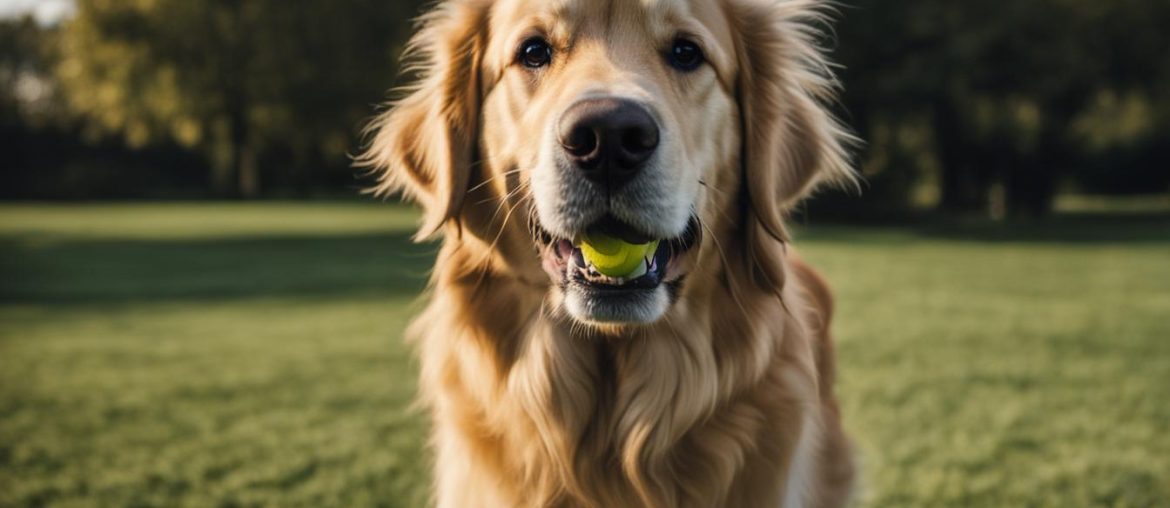Teaching your dog to carry things is a valuable skill that can be both impressive and practical. It requires patience, consistency, and the use of positive reinforcement techniques. By incorporating specific commands and training methods, you can teach your dog to pick up, hold, and drop objects on command.
During the training process, understand your dog’s behavior and tailor your approach accordingly. Positive reinforcement, such as treats and praise, will motivate your dog to learn and perform the desired tasks. By using clear and consistent commands, you can effectively communicate with your dog and guide them through the learning process.
To get started, select a specific item for your dog to carry, such as a toy or a lightweight object. Introduce the object to your dog and use commands like ‘pick it up’ and ‘hold it’ while rewarding them for their cooperation. Gradually increase the difficulty of the task as your dog becomes more comfortable and confident.
Key Takeaways:
- Teaching your dog to carry things requires patience, consistency, and positive reinforcement.
- Choose a specific item for your dog to carry and use clear commands to train them.
- Training your dog to carry things can be useful for tasks and activities around the house or on the go.
- Positive reinforcement, such as treats and praise, will motivate your dog to learn and perform the desired tasks.
- Gradually increase the difficulty of the task as your dog becomes more comfortable and confident.
Benefits of Teaching Your Dog to Carry Things
Teaching your dog to carry things can have numerous benefits for both you and your furry friend. Not only does it provide them with a sense of purpose and responsibility, but it also helps to keep them mentally and physically stimulated. By incorporating positive reinforcement techniques into their training, you can teach them to pick up and hold objects on command, which can be useful in various situations.
One of the main benefits of teaching your dog to carry things is the mental stimulation it provides. Dogs are intelligent creatures that thrive on having a job to do. By assigning them the task of carrying objects, you give them a sense of purpose and help to satisfy their natural instincts. This can help prevent boredom and unwanted behaviors that may arise from a lack of mental stimulation.
Additionally, teaching your dog to carry things can redirect their attention away from undesirable behaviors. When your dog has a specific item to focus on, they are less likely to engage in behaviors such as excessive barking, digging, or destructive chewing. Instead, their attention is directed towards their task, keeping them engaged and occupied.

In practical terms, having your dog carry their own supplies can make outings easier for you. Whether you’re going for a walk, hiking, or running errands, your dog can carry items such as their own water bottle, collapsible bowl, or poop bags. This not only lightens your load but also gives your dog a sense of responsibility and helps to build their confidence in public settings.
The Benefits of Teaching Your Dog to Carry Things:
- Mental and physical stimulation
- Redirects attention from unwanted behaviors
- Eases outings by having your dog carry their own supplies
- Builds confidence and a sense of responsibility
Overall, teaching your dog to carry things is a valuable skill that can have numerous benefits for both you and your furry friend. With patience, consistency, and positive reinforcement, you can help them develop this useful ability, keeping them mentally stimulated and engaged while making your life a little easier.
Getting Started with Training
To teach your dog to carry things, start with the basics. Here are some steps to get you started:
- Gather their favorite treats as rewards and a variety of items for them to carry.
- Find a quiet place for training sessions, away from distractions.
- Introduce the object and use the command ‘pick it up’ while rewarding them for touching or holding it.
- Gradually increase the time they hold the object and reinforce the command ‘hold’.
Try to be patient and consistent during the training process. It may take time for your dog to understand and follow the commands, so positive reinforcement is key.
Creating a Training Plan
Having a training plan can help you stay organized and focused during the teaching process. Here’s an example of a training plan for teaching your dog to carry things:
| Week | Training Focus |
|---|---|
| Week 1 | Introduce the object and reward for touching it |
| Week 2 | Hold the object for a few seconds and reward |
| Week 3 | Hold the object for longer periods and reinforce the ‘hold’ command |
| Week 4 | Practice carrying the object and gradually increase the distance |
“Training your dog to carry things requires patience and positive reinforcement. I recommend that you start small and gradually increase the difficulty as your dog becomes more comfortable with the commands.”
Try to always end each training session on a positive note, even if progress is slow. Consistency and patience will help your dog become a pro at carrying things in no time!
Introducing the Dog Backpack
Once your dog is comfortable with carrying objects, you can introduce them to a dog backpack. This is a great way to further engage their mind and provide them with a sense of purpose during outings. The dog backpack allows your furry friend to carry their own supplies, making it easier for you and keeping them mentally and physically stimulated.
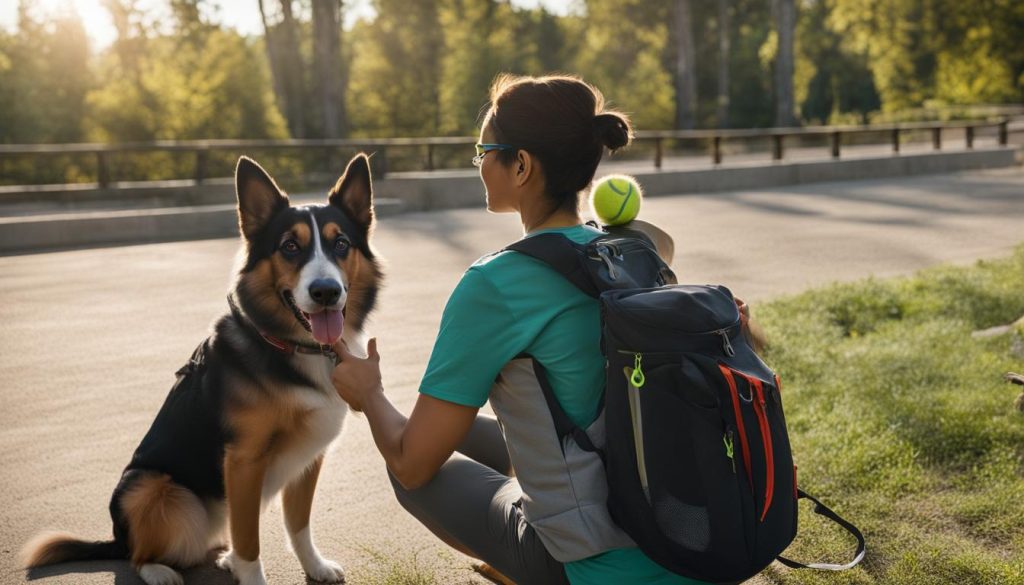
When introducing the dog backpack, start by allowing your dog to examine it. Let them sniff and investigate the backpack to become familiar with it. This will help alleviate any anxiety they may have towards the new object. Gradually, begin putting the backpack on your dog without attaching it. Use treats and praise to reward them for standing still during this process.
Once your dog is comfortable with the backpack on their back, close the clasps and adjust the fit accordingly. Ensure that the backpack is secure but not too tight, allowing your dog to move comfortably. Make sure the weight of the backpack is evenly distributed on both sides for balance and stability. Start with empty saddlebags and gradually add weight as your dog becomes more accustomed to wearing the backpack.
Benefits of Introducing a Dog Backpack
Introducing a dog backpack brings about several benefits for both you and your furry companion. It provides them with a sense of purpose and responsibility, giving them a job to do during outings. This can also help redirect their attention away from undesirable behaviors, as they are focused on carrying the backpack and its contents.
“Allowing your dog to carry their own supplies lightens your load and makes outings more convenient.”
In addition, having your dog carry their own supplies lightens your load and makes outings more convenient. Instead of carrying all the necessary items yourself, your dog can help share the load. This is especially useful for hiking trips or long walks, where you may need to bring food, water, toys, or waste bags. It also provides a great mental and physical workout for your dog, keeping them engaged and stimulated during the journey.
| Benefits of Introducing a Dog Backpack |
|---|
| Provides a sense of purpose and responsibility for your dog |
| Redirects attention away from undesirable behaviors |
| Allows your dog to share the load during outings |
| Mentally and physically stimulates your dog |
What Can Your Dog Carry in a Backpack?
When it comes to choosing what your dog can carry in their backpack, the possibilities are endless. Here are some ideas to get you started:
Food and Water
Your dog can carry their own food and water supplies in their backpack. This is especially useful for hiking or long walks where access to food and water may be limited. Just be sure to choose lightweight, compact containers that won’t take up too much space in the backpack.
Toys and Playtime
Include a favorite toy or a small Frisbee in your dog’s backpack. This way, they can carry their own entertainment and have something to chew on during breaks. It’s a great way to keep them engaged and happy during outings.
Poop Bags
Carrying empty poop bags in your dog’s backpack is not only convenient but also responsible. You’ll always have bags on hand for cleaning up after them, ensuring you leave no trace behind.
Hiking Essentials
If you enjoy hiking with your dog, they can carry small essentials such as a collapsible bowl for water, a small first aid kit, and a lightweight towel. These items can come in handy during your outdoor adventures.
| Items | Description |
|---|---|
| Food and Water | Your dog’s food and water supplies for outings. |
| Toys and Playtime | A favorite toy or small Frisbee for entertainment. |
| Poop Bags | Empty bags for cleaning up after your dog. |
| Hiking Essentials | A collapsible bowl, first aid kit, and towel for outdoor adventures. |
To put it simply, ensure the weight is balanced evenly on both sides of the backpack and does not exceed 25% of your dog’s body weight. Start with lighter items and gradually increase the load as your dog becomes more comfortable carrying their backpack. Pay attention to their body language and adjust accordingly to ensure their comfort and safety.
Having your dog carry items in a backpack not only gives them a sense of purpose but also lightens your load during outings. It’s a win-win situation that enhances the bond between you and your furry companion. So, start exploring the possibilities and enjoy the benefits of having a dog who can carry their own supplies!
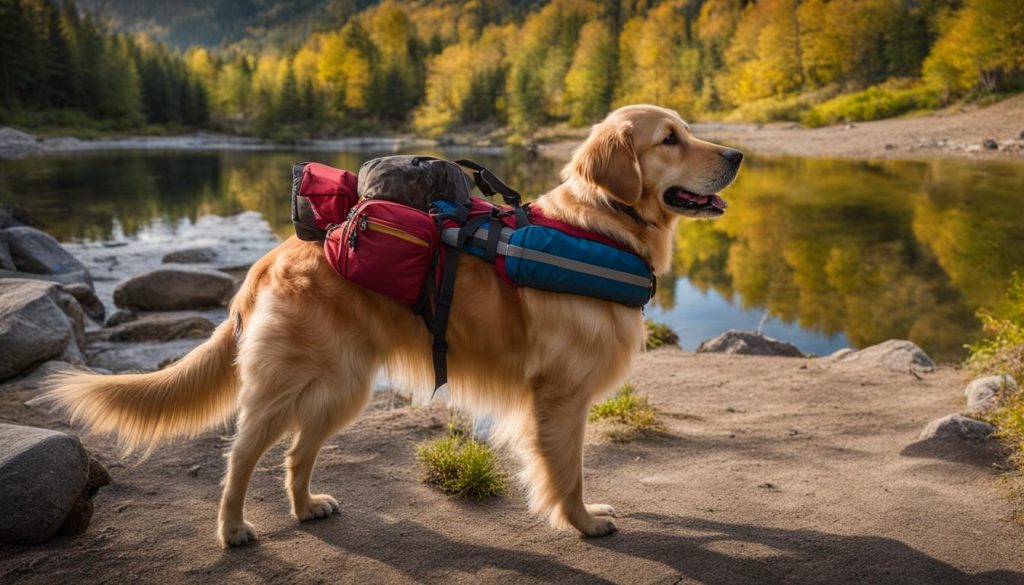
References:
- https://www.akc.org/expert-advice/training/can-dogs-carry-backpacks/
- https://www.caninejournal.com/dog-backpacks/
“Having your dog carry their own supplies not only lightens your load but also gives them a sense of purpose.”
Choosing the Right Dog Backpack
When it comes to choosing the right dog backpack, there are a few key factors to consider. The backpack should be specifically designed for dogs, ensuring a proper fit and maximum comfort for your furry friend. Look for a backpack that is waterproof and fully adjustable, allowing you to customize the fit for your dog’s unique body shape and size.
I recommend that you choose a backpack that has padded contact points, such as shoulder straps and a chest strap, to prevent any discomfort or rubbing. This will ensure that your dog can wear the backpack for longer durations without any issues. Additionally, the backpack should have durable construction to withstand outdoor adventures and protect the items your dog will be carrying.
Consider the capacity and size of the backpack based on the length and type of outings you have in mind. If you plan on shorter hikes or walks, a smaller backpack may be sufficient. However, if you’re planning longer adventures or backpacking trips, a larger backpack with more storage space may be necessary. Try to always choose a backpack that is appropriate for your dog’s weight and size, ensuring they can comfortably carry the load without strain or discomfort.
Table: Comparison of Dog Backpack Features
| Feature | Backpack A | Backpack B | Backpack C |
|---|---|---|---|
| Waterproof | Yes | No | Yes |
| Fully Adjustable | Yes | Yes | No |
| Padded Contact Points | Yes | No | Yes |
| Durable Construction | Yes | Yes | Yes |
| Storage Capacity | Medium | Large | Small |
| Weight Limit | 30 lbs | 40 lbs | 20 lbs |
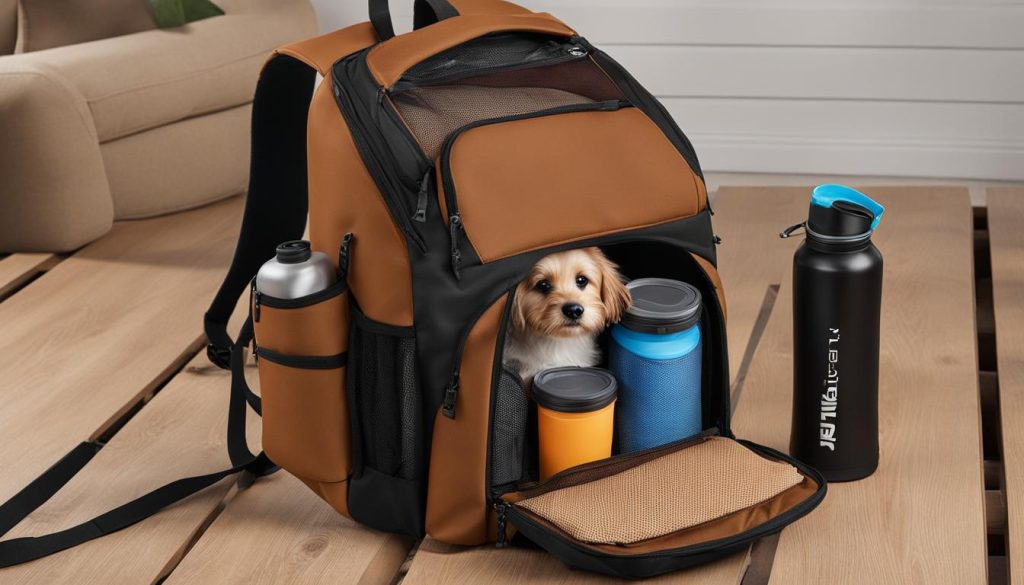
Adjusting the Backpack Fit
When teaching your dog to carry things using a backpack, please ensure that the backpack fits properly. A well-fitted backpack allows your dog to move comfortably and safely while carrying items. Here are some tips on adjusting the backpack for the best fit:
1. Snug, but not too tight
The straps of the backpack should be snug, but not so tight that they restrict your dog’s movement or cause discomfort. You should be able to fit a finger or two comfortably between the straps and your dog’s body.
2. Weight distribution
The weight of the backpack should be evenly distributed on both sides to prevent strain or imbalance. Ensure that the load does not exceed 25% of your dog’s body weight to avoid placing excessive strain on their muscles and joints.
3. Avoiding pressure on the spine
The backpack should rest on your dog’s torso, not their spine. Position the backpack slightly forward from the shoulder blades to prevent unnecessary pressure on the spine. This alignment allows for a more natural gait and reduces the risk of discomfort or injury.
By following these adjustment guidelines, you can ensure that your dog’s backpack fits securely and comfortably. A properly adjusted backpack will make the carrying experience enjoyable for your dog and promote their confidence and enthusiasm during training.
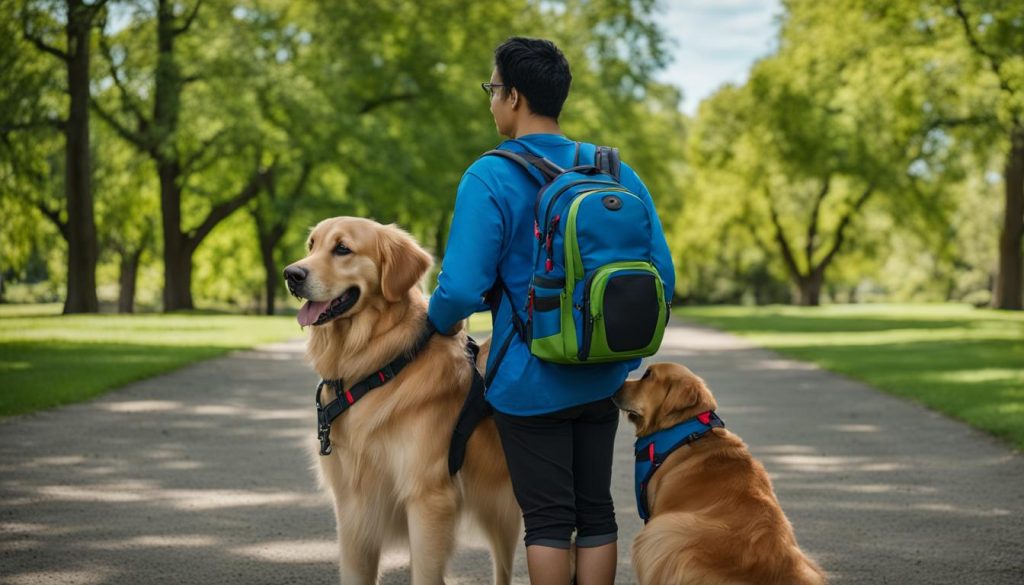
| Benefits of Adjusting the Backpack Fit | Key Points |
|---|---|
| Comfortable Fit | A well-fitted backpack prevents discomfort and chafing during training sessions. |
| Proper Weight Distribution | An even distribution of weight reduces the risk of strain or injury to your dog’s muscles and joints. |
| Optimized Performance | A properly adjusted backpack allows your dog to move freely and maintain a natural gait, enhancing their overall performance during training. |
| Safe and Secure | An appropriately fitted backpack ensures that the load is stable and balanced, minimizing the risk of accidents or discomfort for your dog. |
Gradually Increasing Weight and Challenges
To effectively train your dog to carry things, gradually increase the weight and challenges they face. This will help strengthen their muscles and build their confidence in carrying heavier loads. Start with light objects and gradually increase the weight over time.
Use positive reinforcement techniques such as treats and praise to encourage your dog to pick up and hold the objects for longer periods. Start by rewarding them for simply touching the object, then gradually increase the duration they hold it.
As your dog becomes more comfortable with carrying objects, you can introduce challenges such as navigating stairs, curbs, and obstacles while holding the items. Reward their progress and provide encouragement throughout the process. This will help them develop the skills needed to confidently carry things in different environments.
| Training Steps | Weight and Challenges |
|---|---|
| Step 1: Touch and Hold | Start with lightweight objects and reward your dog for touching and holding them. |
| Step 2: Increase Duration | Gradually increase the time your dog holds the object before rewarding them. |
| Step 3: Introduce Challenges | Once your dog is comfortable with holding objects, introduce challenges like navigating stairs and obstacles. |
| Step 4: Increase Weight | As your dog becomes stronger and more confident, gradually increase the weight they carry. |
Try to always use positive reinforcement techniques and be patient with your dog’s progress. Each dog learns at their own pace, so tailor the training to their individual needs. With consistency and positive reinforcement, your dog will become a pro at carrying things in no time!
Safety Tips for Backpacking with Your Dog
When embarking on a backpacking adventure with your canine companion, it is essential to prioritize their safety. Here are some important tips to ensure a safe and enjoyable experience for both you and your dog:
- Check the weather forecast: Before hitting the trails, make sure to check the weather conditions for your hiking destination. Extreme heat, thunderstorms, or heavy rains can pose risks to your dog’s well-being. It’s best to plan your hike on a day with mild temperatures and clear skies.
- Carry dog-specific essentials: Just like you pack your own supplies, pack essential items for your dog as well. These may include a first aid kit, extra water, food, collapsible bowls, a leash, waste bags, and any necessary medications. Adapting to your dog’s needs will ensure their comfort and safety throughout the journey.
- Protect their paws: The rugged terrain encountered during backpacking trips can be tough on your dog’s paws. Consider using paw protectors or booties to shield their paws from sharp rocks, thorns, or hot surfaces. Regularly check their paws for any signs of injury such as cuts, blisters, or foreign objects.
- Hydration is key: Always carry an adequate supply of water for your dog. They will require frequent hydration breaks, especially during strenuous activities. Try to pack a collapsible water bowl and offer water regularly to prevent dehydration.
- Practice proper leash etiquette: Keeping your dog on a leash is essential for their safety and the well-being of other hikers and wildlife. Ensure your dog’s leash is sturdy and secure, providing them with enough freedom to explore without compromising their safety or disturbing others.
- Be mindful of wildlife encounters: While enjoying the great outdoors, be aware of the wildlife that may cross your path. Keep your dog under control and avoid confrontations with wild animals. This helps protect both your dog and the natural environment.
- Monitor their energy levels: Pay close attention to your dog’s energy levels during the hike. Dogs can easily become fatigued, especially on longer or more challenging trails. If your dog shows signs of exhaustion, take frequent breaks and provide them with a quiet, shaded area to rest.
By following these safety tips, you can ensure a successful backpacking experience with your furry friend. To put it simply, their safety and well-being should always be your top priority.

Quote:
“Safety is a crucial aspect of backpacking with your dog. By taking the necessary precautions and being attentive to your dog’s needs, you can create unforgettable memories while keeping them safe during the journey.” – Anonymous
Table: Essential Dog Supplies for Backpacking
| Item | Description |
|---|---|
| First Aid Kit | A kit containing bandages, antiseptic, tweezers, and other supplies to treat minor injuries |
| Extra Water | Sufficient water supply to keep your dog hydrated throughout the hike |
| Food | Portable and easily accessible dog food that provides necessary nutrition |
| Collapsible Bowls | Compact bowls for food and water that are easy to carry |
| Leash | A strong and reliable leash to keep your dog under control |
| Waste Bags | Bags to clean up after your dog and ensure responsible waste disposal |
| Paw Protectors | Booties or paw protectors to shield your dog’s paws from rough terrain |
| Medications | If your dog requires any medications, ensure you have an adequate supply |
Enjoying the Benefits of a Backpacking Dog
Training your dog to carry things and wear a backpack comes with numerous benefits. Not only does it provide a stimulating and fulfilling job for your furry friend, but it also lightens your load when you’re out and about. When your dog becomes comfortable wearing a backpack and carrying items, you’ll find that it enhances your adventures and strengthens your bond.
I love watching my dog confidently trotting alongside me on our hikes, proudly carrying his own supplies. It’s such a rewarding sight to see him embracing his responsibilities and enjoying the outdoors as much as I do. Having a backpacking dog has made our outings more convenient and enjoyable for both of us.
The positive reinforcement used during training not only teaches your dog to carry items but also helps to redirect their focus and energy away from undesirable behaviors. By keeping their minds engaged and their bodies active, you’ll find that your dog is more content and well-behaved.
Additionally, incorporating backpack training into your daily life provides continuous mental and physical stimulation for your dog. Whether it’s on walks, hikes, or other outdoor activities, having your dog carry their own supplies allows you to fully enjoy your time together and provide them with a sense of purpose.
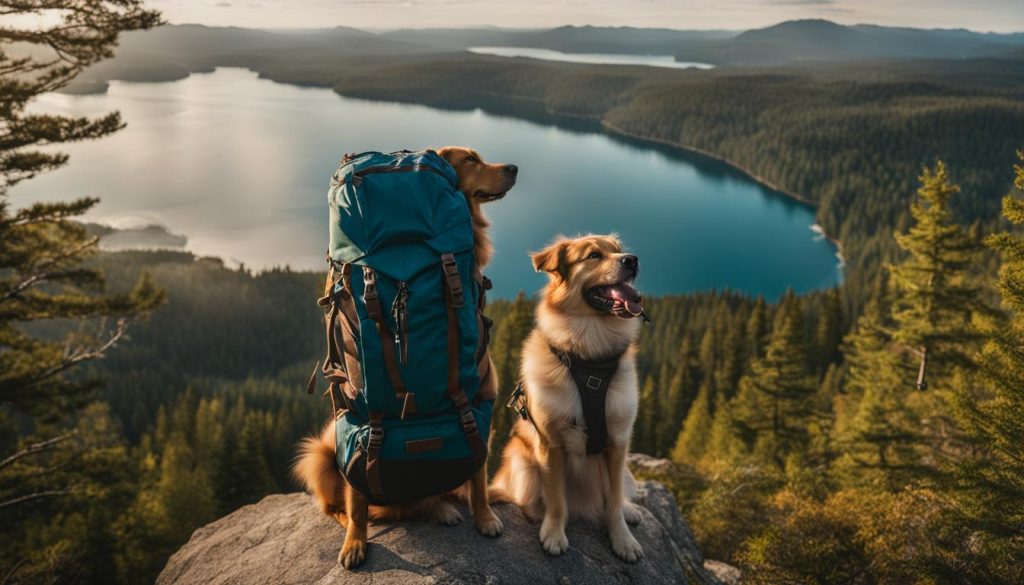
Table: Benefits of Training Your Dog to Carry Things
| Benefits | Description |
|---|---|
| Enhanced mental stimulation | Your dog stays focused and engaged during training and outings. |
| Physical exercise | Carrying a backpack adds to the intensity of your dog’s workout. |
| Redirection of attention | Training them to carry items diverts their focus away from undesirable behaviors. |
| Convenience | Your dog carries their own supplies, lightening your load. |
| Bonding and teamwork | Working together strengthens the bond between you and your dog. |
As you can see, the benefits of training your dog to carry things and be a backpacking companion are numerous. It’s a win-win situation for both you and your furry friend, providing mental and physical stimulation, convenience, and improved behavior. So, grab your dog’s backpack and hit the trails together!
Incorporating Dog Backpack Training into Daily Life
Now that your dog is trained to use a backpack, you can seamlessly incorporate it into your daily activities. This not only helps reinforce their training but also allows them to fully utilize their newfound skills. Here are some practical ways to incorporate dog backpack training into your daily life:
1. Daily Walks: Take your dog on their regular walks while they wear their backpack. This gives them a purpose and allows them to carry their own supplies, such as poop bags or a water bottle. It also provides them with mental and physical stimulation, making their walks more engaging and enjoyable.
2. Errands and Outings: When running errands or going on outings, have your dog carry items that you would typically bring along. For example, they can carry their own collapsible water bowl, treats, or a small toy. This not only lightens your load but also gives your dog a job to focus on, keeping them mentally engaged.
3. Ongoing Training: Continue practicing commands like ‘pick it up’ and ‘hold it’ during your daily routine. This helps reinforce their training and keeps their skills sharp. You can incorporate these commands when your dog retrieves their backpack or any other item you want them to carry.
Benefits of Incorporating Dog Backpack Training into Daily Life
There are several benefits to incorporating dog backpack training into your daily life:
- Mental and Physical Stimulation: By carrying a backpack, your dog engages both their body and mind. This helps prevent boredom and can reduce unwanted behaviors that may result from excess energy.
- Independence: Teaching your dog to carry their own supplies fosters a sense of independence. They learn to take responsibility for their belongings, making them more self-reliant.
- Bonding Time: Incorporating dog backpack training into your daily routine provides additional opportunities for quality bonding time with your furry friend. It strengthens your relationship as you work together towards a common goal.
- Practicality: Having your dog carry their own supplies can be incredibly practical. It frees up space in your bag or pockets and ensures that your dog is responsible for their own essentials while on outings or hikes.
Try to gradually increase the weight and challenges for your dog as they become more comfortable with their backpack. Always use positive reinforcement and rewards to motivate them during their training. With consistency and patience, your dog will continue to excel in their backpack training and enjoy all the benefits it brings.
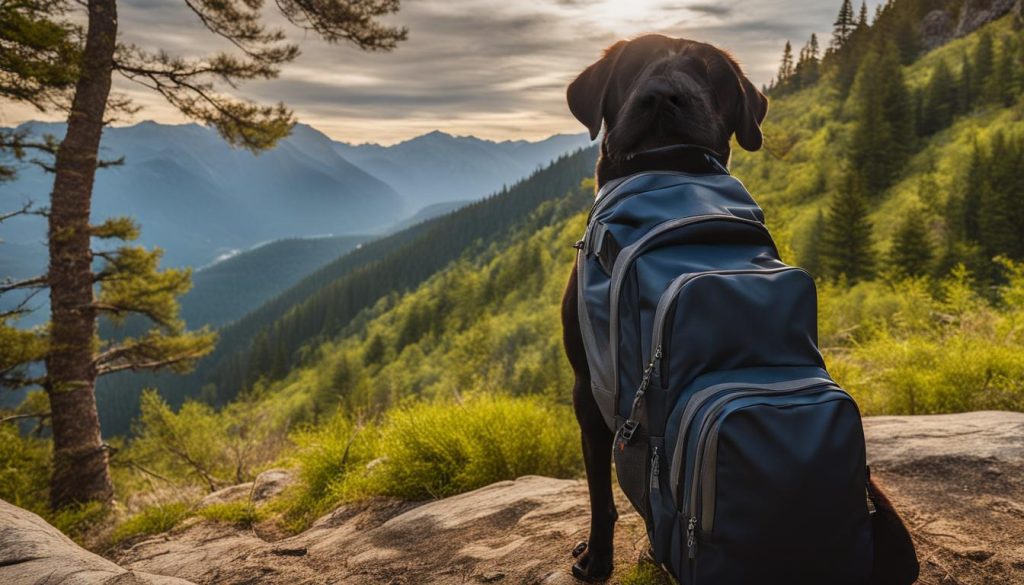
Final Thoughts
In conclusion, teaching your dog to carry things is a rewarding and beneficial endeavor. Through dog training techniques that emphasize positive reinforcement and consistency, you can successfully train your furry friend to pick up and hold objects on command.
By gradually increasing the challenges and introducing a dog backpack, you can further enhance their skills and enjoy the benefits of having a backpacking dog. Not only will your dog feel fulfilled by their important job, but you can also lighten your load during outings.
Incorporating dog backpack training into daily life, such as taking them on walks or hikes with the backpack, allows your dog to maintain their skills and provides mental and physical stimulation. Additionally, it strengthens your bond and provides quality time together.
Overall, training your dog to carry things is a valuable skill that can bring numerous advantages. So, start the training journey with patience, consistency, and positive reinforcement, and watch as your dog becomes a successful little helper.
FAQ
How do I teach my dog to carry things?
To teach your dog to carry things, you can use commands like ‘pick it up’, ‘hold it’, ‘fetch’, and ‘drop it’. Start by introducing the object and rewarding them for touching or holding it. Gradually increase the time they hold the object and reinforce the command ‘hold’.
What are the benefits of teaching my dog to carry things?
Teaching your dog to carry things gives them a job to do, keeps them mentally and physically stimulated, and helps redirect their attention away from undesirable behaviors. It can also make outings easier for you, as your dog can carry their own supplies.
How do I get started with training my dog to carry things?
Gather your dog’s favorite treats as rewards and a variety of items for them to carry. Find a quiet place for training sessions and start by introducing the object and using the command ‘pick it up’ while rewarding them for touching or holding it. Gradually increase the time they hold the object and reinforce the command ‘hold’.
How do I introduce my dog to a dog backpack?
Allow your dog to examine the backpack and gradually put it on them without attaching it. Treat and praise them for standing still during this process. Once they are comfortable, close the clasps and adjust the fit of the backpack. Start with empty saddlebags and gradually add weight as they get accustomed to wearing the backpack.
What can my dog carry in a backpack?
Your dog can carry a variety of items in their backpack, such as their own food and water, a Frisbee or toy, empty poop bags, or small items needed for hiking. Ensure the weight is balanced evenly on both sides of the backpack and does not exceed 25% of your dog’s body weight.
How do I choose the right dog backpack?
Look for a dog backpack specifically designed for dogs that is waterproof and fully adjustable. The backpack should have padded contact points for comfort. Consider the capacity and size based on the length and type of outings you plan to do with your dog.
How do I adjust the fit of the dog backpack?
The straps should be snug, but not too tight, allowing you to fit a finger or two comfortably. The weight of the backpack should lie on your dog’s torso, not their spine. Use the adjustable straps to customize the fit and prevent the load from shifting during hikes.
How do I gradually increase weight and challenges for my dog?
Start with light weight in the dog backpack and gradually increase the load as your dog becomes more comfortable. Begin with empty saddlebags and then add equal weight to both sides. Teach your dog to navigate stairs, curbs, and obstacles with the backpack, rewarding them for their progress.
What are some safety tips for backpacking with my dog?
Remove the saddlebags when crossing rivers or streams. Monitor your dog for signs of overheating and offer frequent water breaks. Check their feet and pads for wear and tear, and be aware of chafing from the backpack straps.
What are the benefits of having a backpacking dog?
Having a backpacking dog gives them a fulfilling job to do and allows you to lighten your own load on outings. It’s a great way to spend quality time together and keep your dog mentally and physically stimulated.
How do I incorporate dog backpack training into daily life?
Take your dog on walks or hikes with the backpack, have them carry their own supplies, and reinforce their training by using commands like ‘pick it up’ and ‘hold it’. Regular practice will help them maintain their skills of carrying things.
Is teaching my dog to carry things a rewarding skill?
Yes, teaching your dog to carry things is a rewarding and useful skill. With patience and positive reinforcement, you can teach your dog to pick up and hold objects on command. It provides mental and physical stimulation for your dog and can be helpful for tasks around the house or on the go.


